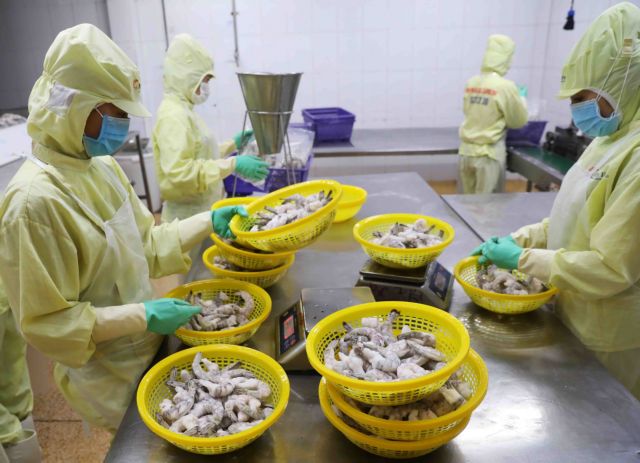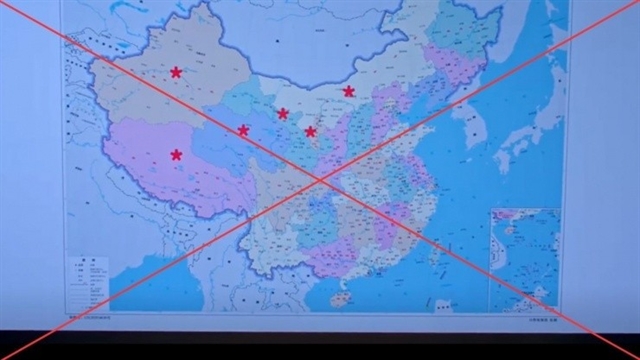 Economy
Economy

 |
| The agricultural sector had seven groups of products recording an export turnover of over $1 billion in the first half of 2023, including shrimp. VNA/VNS Photo Vũ Sinh |
HÀ NỘI — The agriculture sector posted a total agro-forestry-fishery export value of US$24.59 billion in the first half of 2023, down 11.1 per cent year on year, according to the Ministry of Agriculture and Rural Development (MARD).
Specifically, the export value of main agricultural products reached $12.79 billion, up 12 per cent and livestock products also saw an increase of 26.5 per cent in export value to $232 million.
Meanwhile, the export value declined by 28.2 per cent for main forest products to $6.5 billion; and 27.4 per cent for aquatic products to $4.13 billion.
The agricultural sector had seven groups of products recording an export turnover of over $1 billion, including coffee, rubber, rice, vegetables, cashew nuts, shrimp, and wood products.
Vegetables, rice and cashew nuts were products gaining export growth in both volume and value over the same period of last year.
In the first half of 2023, fruit and vegetable export turnover was estimated at $2.8 billion, including $950 million in June, up 2.6 times compared to June 2022.
The rice export in the six months reached 4.2 million tonnes, earning $2.32 billion, including $300 million in June. The average export price of rice in the first five months of 2023 was estimated at $517 per tonne, up 5.8 per cent over the same period in 2022.
The Philippines was Việt Nam's largest rice consumption market (holding 42.4 per cent of the total export) with growth of 40.6 per cent in volume and 53.4 per cent in value over the same period last year. Việt Nam’s rice exported to China also increased by 93.2 per cent in volume and 116 per cent in value.
Cashew nut exports in the first half of 2023 also grew impressively to reach $1.6 billion, up 7.7 per cent on year. However, the average export price of Việt Nam's cashew nuts fell by 2.4 per cent to $5,850 per tonne.
Meanwhile, coffee exports decreased 2.2 per cent in volume to 1.02 million tonnes, but rose 3 per cent in value to $2.4 billion due to increasing by 5.2 per cent in average export price.
Other agricultural products seeing a reduction in export turnover during the six months included rubber ($1.05 billion), shrimp ($1.56 billion), and wood products ($4.07 billion).
The fishery industry saw a high decline of 32 per cent in shrimp exports to $1.56 billion and 40 per cent in the tra fish export to $840 million in the first six months.
According to the Association of Seafood Exporters and Producers (VASEP), Việt Nam's seafood exports to the US in the first half of this year nearly halved against the same period in 2022. All major seafood products experienced a sharp decline of 30-60 per cent. Of which, the two main products, shrimp and pangasius, fell the most, with rates of 42 per cent and 62 per cent, respectively, compared to the same period last year.
Regarding export markets, China, the US and Japan continued to be the three largest export markets for Việt Nam's agricultural, forestry and fishery products.
Of which, the export value to China accounted for 21.4 per cent of the total export turnover of agriculture, forestry and fishery. The exports increased by 7.7 per cent over the same period last year.
Exports to the US accounted for 20.2 per cent of the total turnover, decreasing by 32.9 per cent, while exports to Japan accounted for 7.7 per cent, down 5.3 per cent over the same period last year
By this year end, the exports of all sectors will have many changes. Especially, the Việt Nam Fruit and Vegetable Association said the fruit and vegetable industry would probably reach $4 billion in 2023, up 20 per cent compared to last year. This increase is completely feasible if Việt Nam's durian exports gain the targeted over $1 billion.
The Việt Nam Food Association (VFA) forecasts that Việt Nam's rice exports would maintain a positive growth from the second quarter until this year-end. Especially, due to the impact of economic and political uncertainties and the increasing demand for food reserves in other countries, the export price of rice remains at a high level.
Meanwhile, VASEP has forecast seafood exports to recover in the second half of 2023, with a brightening outlook from the US market.
It is forecast that in the third quarter, US importers will release all inventories. They will promote seafood imports, including from Việt Nam in the fourth quarter because the inventory has run out and the high demand for vacations at the end of the year.
To restore the exports of some key commodities for achieving the export target of $55 billion in 2023, MARD will closely coordinate with the Ministry of Industry and Trade to implement mechanisms and policies on increasing trade promotion activities, and negotiations on opening up and developing export markets, as well as to solve problems in agricultural, forestry and fishery exports, according to the ministry.
MARD grasps the situation of production, processing and consumption of agricultural products, and border trade activities to implement urgent measures to promote the export of agricultural products at border gates in the North, especially the agricultural products in the harvest season.
In addition, it will coordinate with embassies and trade offices of Việt Nam in other countries to build channels for exchanging and providing information on export markets.
They will also enhance trade promotion for products that are officially exported to major and potential markets, such as China, the US, the EU, Russia, Brazil, Japan, South Korea, ASEAN, Australia, New Zealand, the Middle East, and Africa.
In the third quarter, MARD will negotiate to export fresh coconuts to the US, and come to an agreement with Japan on a new stamp for Vietnamese mango and dragon fruit exported to Japan from August 1, 2023.
The ministry said that in the third quarter, it would work with the General Administration of Customs of China to finalise a draft protocol on the requirements of importing Vietnamese chilli and traditional fresh fruits to China, except for bananas. It also organises an online meeting with the General Administration of Customs of China to remove difficulties and obstacles in the export of agricultural products.
MARD would work with the EU's inspection delegation to evaluate Việt Nam's food safety control system and seafood processing enterprises. — VNS




